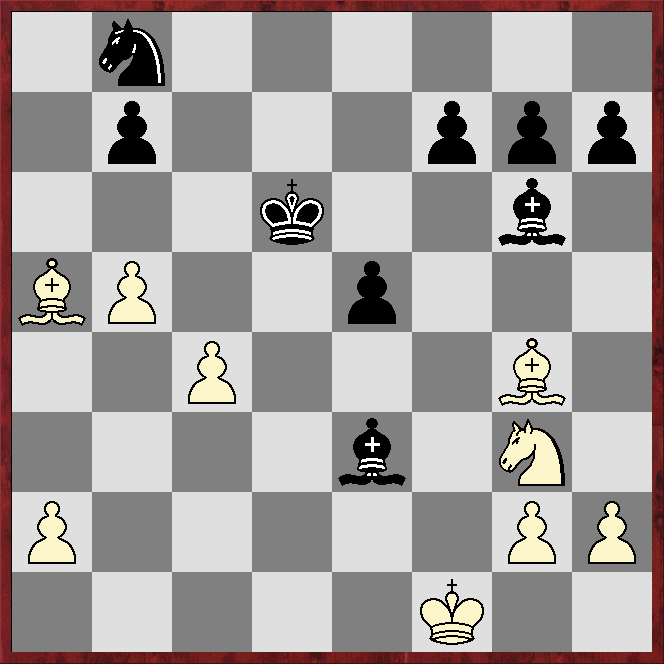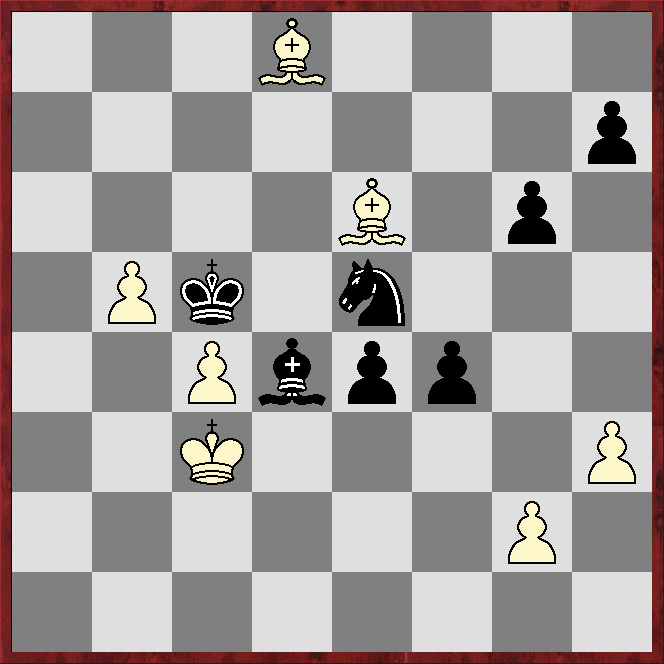Faced a junior (born 2008).
Olga Latypova (1542 Fide/1819 ECF) - Spanton (1858 Fide/1919 ECF)
Sicilian Maróczy Bind
1.e4 c5 2.Nf3 g6 3.d4 cxd4 4.Nxd4 Nc6 5.c4 Bg7 6.Be3 Nf6 7.Nc3 d6 8.Be2 0-0 9.0-0 Bd7
 |
| There are 13,456 games with this position in ChessBase's 2023 Mega database |
*****
*****
*****
*****
*****
10.f3
Géza Maróczy played 10.h3 in a 1906 game, the same move as had been played against him two years earlier by Rudolf Swiderski in the first known example of the Bind (it was named after Maróczy because of his advocation of c4 in Sicilian-like structures).
10...Nxd4 11.Bxd4 Bc6
This is fine - indeed it is the main move in Mega23 - but one of the points of ...Bc6 is to oblige White to reply f3, slowing down any White kingside attack. Stockfish16 and Komodo14.1 suggest, among other moves, 11...Nh5!?, the point being White should normally be reluctant to give up the dark-square bishop in Maróczy Bind structures even if in doing so the black fianchettoed bishop is exchanged. If White avoids the exchange with 12.Be3, then 12...Bxc3!? is interesting. However, ...Bc6 is not played just to put pressure on e4, but also to clear a square for the black king's knight to reroute to c5.
12.Be3 Nd7 13.Qd2 Nc5 14.Rfd1
Possible is 14.b4!? as 14...Na4 can be met by 15.Nxa4, when Black has to reply 15...Bxa4, allowing, for example, 16.Rac1, as 15...Bxa1? is hit by 16.b5, as in Dana Reizniece-Ozola (2312) - Margeir Pétursson (2487), Pühajärve (Estonia) Rapid 2018 (1-0, 51 moves).
14...a5 15.Qc2 Qb6 16.Rab1 a4 17.Kf2?!
There are probably too many pieces on the board to bring the king forward like this, especially as it is now on the same file as a black rook.
17...f5 18.exf5 Rxf5 19.Nd5 Bxd5 20.Rxd5 Rxd5 21.cxd5 Rc8 22.b4!?
Black is forced to capture, and so the white rook comes into play.
22..axb3 23.Rxb3 Qc7 24.Rb5 Qd7 25.Qb1 Rc7 26.Ra5 Be5 27.Bb5 Qd8 28.Ra7 e6!?
It is risky opening lines when the opponent has the bishop-pair.
29.g3 exd5 30.Qd1 d4 31.Bxd4 Qf6?
Better is 31...Bxd4+ 32.Qxd4 and either 32...Ne6 or 32...d5. Stockfish16 reckons that is equal, but Komodo14.1 prefers White.
32.Bc4+?
Missing the win of a pawn by 32.Bxc5 dxc5 33.Qd5+ and Rxb7. The engines reckon it is better to give up the b pawn by 32...Rxc5, but White is on top.
32...Kg7?
The game is completely equal after 32...Ne6, according to the engines.
33.Bxc5
Even stronger, according to the engines, is 33.Be3!?, when the threat of Qd5 is hard to meet. Best play may be 33...Ne4+ 34.Kg2 Nc3 35.Qd3, after which the black knight is awkwardly placed, and Black has the less-safe king.
33...dxc5 34.Qd5 Bd4+ 35.Kg2 Qb6 36.Ra8 Qb2+ 37.Kh3 Qg1 38.Qg8+ Kh6 39.Qf8+ Qg7?!
Completely equal is 39...Rg7, according to the engines.
40.Qf4+ g5 41.Qd6+ Qg6 42.Qxg6+?!
White has the upper hand, according to the engines, after 42.Rd8 Qxd6 (forced) 43.Rxd6+ Kg7 44.a4.
42...Kxg6 43.Rg8+ Kf6 44.Kg2 Bd4 45.Rf8+ Ke5 46.Re8+
OL offered a draw in my time (just).
 |
| Most of the rest of the game is the story of me overpressing in an equal - at best - position while my opponent is more-or-less on the increment |
*****
*****
*****
*****
*****
46...Kd6 47.Re6+ Kd7 48.Rh6 Ke8 49.Be6+
White is at least slightly better after 49.h4, according to the engines.
49...Kb8 50.Bf5 Re7 51.Bd3 Re3 52.Bc4 Rc3 53.Bd5 Rc2+ 54.Kf1!?
Arguably more ambitious is 54.Kh3, although Stockfish16 reckons both moves give complete equality. However Komodo14.1 at first reckons Black has a slight edge after the text, but eventually switches to equality.
54...b5 55.Rxh7 b4 56.Re7!?
The natural 56.h4 is rated only marginally better by the engines.
56...Rxh2 57.Re8+ Kc7 58.Rg8 Ke6 59.Rxg5 Rh1+ 60.Ke2 Be5?!
The engines reckon 60...Rh2+ and 60...Bf6 give equality.
 |
| How should White proceed? |
*****
*****
*****
*****
*****
61.f4?!
Preserving the bishop gives White at least a slight edge, according to the engines.
61...Rh2+ 62.Kd3 Bc3?
Continuing to look for traps, but now the engines reckon White is winning. Correct is 62...Kxd5.
63.Bb3 Rd2+ 64.Kc4 Bd4 65.Rg6+ Ke7 66.g4 Be3 67.f5 Bd4 68.g5 Rg2 69.Re6+?!
White seems to be still winning after this, but much stronger is 69.f6+.
69...Kf8 70.g6?
Black has a draw after this, while 70.Rg6 looks good, eg 70...Be3 71.Rc6! Rxg5 72.Kd3 Bd4 73.f6 (threatening 74.Rc8#) Re5 74.Be6, after which Black has to give up the exchange.
 |
| Black to play and draw |
*****
*****
*****
*****
*****
70...Rg4?
I offered a draw, but I should have played 70...Rf2, which does draw as White cannot save the f pawn.
71.Kb5 Rf4
 |
| White to play and win |
*****
*****
*****
*****
*****
72.f6?
Winning is 72.Bc2, eg 72...Rf2 73.Be4 Rxa2 74.f6 Ra7 75.Bd5 etc.
72...Bxf6!? 73.Kxc5 Kg7 74.Re2
OL offered a draw in my time.
74...Kxg6 75.Bc2+ Kg7 76.Re4 ½–½




















































